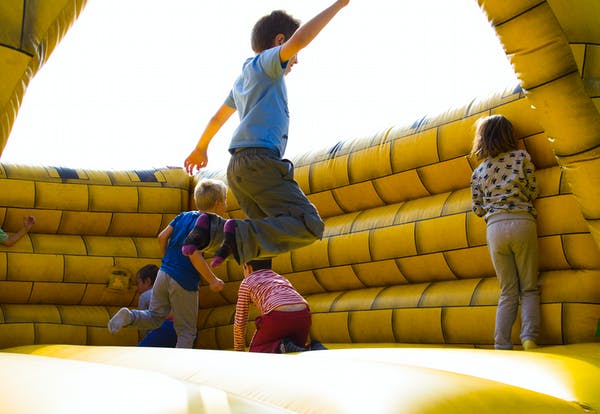Whether it’s healthy eating, exercise, personal hygiene, organising schoolwork or anything else we want to build good habits around for young people – there’s no denying that childhood is a key time to instil practices that will help them develop into happy, healthy and well-rounded adults. Whilst many guidelines remain the same throughout our lives, such as eating plenty of vitamins and minerals, limiting less nutritious foods and keeping active, there are certain specific recommendations for children in order to best support their health and development. This blog covers some of the key guidelines for children and young people and suggests some ways in which they may manage to hit their daily exercise target without it feeling like a chore! You never know, they might even have a positive impact on the adults in their lives and encourage a whole-family approach to health and fitness, as there’s no better way to lead than by setting a good example.
For the purpose of this blog, children and young people are those aged 5-18 years of age. The below guidelines are recommendations for the general population and as individual needs vary it may be recommended to seek further advice from a fitness professional with any individual requirements or questions.
What are the benefits of exercise for children and young people?
Can support good concentration and ability to learn
Strengthens muscles and bones
Develops co-ordination and motor skills
Builds confidence and social skills
Improves cardiovascular health and fitness
Helps with healthy weight management
Supports mental health, stress management and encourages healthy coping skills
Can improve sleep and relaxation
It can be great fun!

What exercise should young people be doing?
Just like adults, children should be doing a variety of activities on a regular basis, including both cardiovascular/aerobic exercise and strengthening exercise for their bones and muscles.
Children should aim for around 60 minutes of moderate to vigorous intensity activity a day, which is more than the recommended amount for adults. They should be somewhat breathless and able to talk but not sing during this exercise, which is a simple way to check the intensity is suitable.
As their bodies are still developing, children should aim for a wide variety of different activities in order to encourage well-rounded development of movement, muscles and bones and reduce the chance of injury from overuse.
Children should aim to reduce sedentary time and break up long periods of not moving with some physical activity. Activity should be spread throughout the day if possible.
What activities can help young people to reach their target?
‘Active travel’ – Walking/cycling/scooting to school, an extra-curricular activity, a friend’s house etc (if safe and allowed by parents or guardians). This can be done alone or with others/ supervision.
Active play in the form of running, skipping, throw and catch
PE lessons at school
Joining a sports club or exercise group outside of schooltime. This can help with social skills too.
Swimming
Dancing
Cycling
Walking the dog

For bones and muscles, it’s important that developing bodies aren’t pushed too hard when it comes to resistance training. A child’s need and ability to gain muscle is different to that of an adult for many reasons, and resistance work should focus on healthy development and functional strength and movement for everyday life. This could include body weight exercises such as: squats, sit ups and press ups, exercising with resistance bands, martial arts, gymnastics or many other activities. Many gyms also allow young people (usually high school age or older) in at certain times and light weights or resistance machines can be suitable when used safely and appropriately. A full induction should always be given to ensure the correct guidelines are followed. Being in a gym environment can be a great novelty for young people and is a good time to introduce them to fitness equipment and a more formal fitness environment.
What if they find exercise boring?
There are endless ways to hit activity targets and if the ‘usual’ activities don’t appeal, try some of the ideas below…
Climbing (indoor or outdoor climbing walls and frames)
Ice skating
Roller blading/ skate boarding
Obstacle courses (children’s ninja warrior style)
Bouncy castles/ trampoline parks
Active video games such as wii fit
A family dance off
Family/ friends sports day activities such as races or competitions
Martial arts/ boxing/ self-defence style classes
Horse riding
Dance classes

There are plenty of ways to get in physical activity that are free of charge in the local area too. Parks and green spaces often have playgrounds to encourage a variety of different physical activities as well as open space for ball games such as football and throw and catch. Local cycle paths are designed to be as flat and safe as possible and so are often perfect for children and young people. Leisure centres often offer designated ‘family swim times’ and very young children can often go in free with an adult. During school holidays, many centres over very affordable holiday club/sports camp options for full or half days and they may also have novelty pool activities such as inflatable obstacle courses. Look out for school fairs or local community events which often have opportunities for fun outdoor activities and attractions such as bouncy castles. YouTube is full of child-friendly exercise videos and even learning dances on tik tok counts!
There’s no right or wrong way for young people to hit their exercise targets and the most important thing is to try and find something they enjoy and that fits into their lifestyle and accounts for any other factors such as accessibility and financial means. There really is something to suit everyone when it comes to exercise and with children’s naturally energetic and curious nature, childhood is a great time to explore the options available and set up healthy habits for life.
As always, with any questions please contact Mike at Hamers360fitness or Bev on Instagram @bevs_life
Bev Meadows – Personal Trainer/ Exercise Referral Officer and Complementary Therapist.

